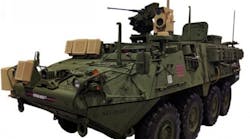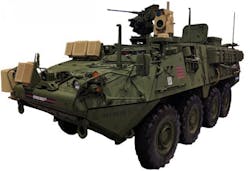Some light has been shed on the growing problem of weapon-carrying unmanned aerial vehicles (UAVs) and how to minimize the threat by means of high-energy directed weapons. Recent testing by the U.S. Army’s Space and Missile Defense Command (SMDC) and Army Forces Strategic Command (ARSTRAT) at White Sands Missile Range, N.M. demonstrated current counter-unmanned aircraft system (C-UAS) capability.
The exercises were part of the Joint Improvised-Threat Defeat Organization (JIDO) UAS Hard-Kill Challenge. They employed the Mobile Expeditionary High Energy Laser 2.0 (MEHEL 2.0) in combination with a Stryker-mounted radar system (see figure), engaging and defeating several small fixed-wing UAVs and quad copters.
“The purpose of the JIDO UAS Hard-Kill Challenge was to assess and look at technology,” said Adam Aberle, SMDC High Energy Laser Division technology development and demonstration lead, “to do a ‘hard-kill’ shoot down of Group 1 [unmanned aircraft systems] and inform decision-makers on the current state of technology, and how it can deal with single and multiple targets.”
A Stryker vehicle serves as a test bed for experiments with the latest version of the MEHEL laser weapon. (Photo courtesy of the U.S. Army)
The upgraded 2.0 version of the MEHEL system employs a 5-kW laser compared to the earlier 2-kW laser. “SMDC, working with industry, put together a system that worked, and we realized there were some limitations,” Aberle noted. “Upgrading from 2kW to 5kW, there were some limitations in the system. We learned from the event, and we have plans to correct those deficiencies for future activities.”
With regard to the on-board radar system, “We were able to verify and show that we could put a radar and a laser on a platform so it could self-cue to targets, and that was very successful,” Aberle expalined. “We look forward to working with industry—and continue to mature the technology—because we believe this technology is critical to the Army, and will be very beneficial once we are able to get the technology mature enough to transition it and field it one day.


